The Art of Sandwich Making: A Master Class
Published on January 20, 2025 by Chef Roberto Silva
After 15 years of perfecting the art of sandwich making, I’ve learned that a great sandwich is so much more than ingredients slapped between bread. It’s architecture, chemistry, and pure creativity. Today, I’m sharing the techniques that will elevate your sandwich game from good to extraordinary.
The Foundation: Choosing Your Bread
Your bread is your canvas - it needs to support your creation without overwhelming it.
Bread Selection Guide
For hearty fillings:
- Sourdough: tangy flavor, sturdy structure
- Ciabatta: crispy crust, airy interior
- Focaccia: rich flavor, absorbs juices beautifully
For delicate fillings:
- Brioche: buttery, soft, luxurious
- Challah: slightly sweet, tender crumb
- Pain de mie: neutral flavor, perfect for showcasing ingredients
For grilled sandwiches:
- Whole grain: nutty flavor, holds up to heat
- Rye: distinctive taste, complements strong flavors
- Pullman loaf: even slices, consistent browning
The Prep
Always toast or grill your bread lightly, even for cold sandwiches. This creates a barrier that prevents sogginess and adds textural contrast.
The Science of Layering
The order of your ingredients isn’t random - it’s strategic.
The Perfect Layer Sequence
- Base spread - Creates moisture barrier
- Cheese (if using) - Goes on toasted surface for melting
- Proteins - The star of your sandwich
- Vegetables - From sturdy to delicate
- Top spread - Final moisture barrier
- Top bread - Lightly toasted
The Spread Strategy
Bottom layer spreads:
- Butter or mayo - prevents sogginess
- Mustard - adds zing without moisture
- Cream cheese - rich barrier for delicate ingredients
Top layer spreads:
- Avocado - creamy richness
- Pesto - herb intensity
- Aioli - garlicky depth
Protein Perfection
The protein is often your sandwich’s star - treat it right.
Slicing Techniques
Against the grain: For all meats, this breaks down tough fibers Thin but not paper-thin: 1/8 to 1/4 inch for most proteins Consistent thickness: Use a sharp knife and steady hand
Temperature Matters
Cold sandwiches: Let proteins come to room temperature for 15 minutes Hot sandwiches: Warm proteins separately before assembling Cheese melting: Add cheese to warm proteins off heat for perfect melt
Vegetable Mastery
Vegetables add crunch, freshness, and nutrition - but they can also sabotage your sandwich.
Moisture Management
Salt and drain: Tomatoes and cucumbers benefit from light salting Pat dry: Always dry lettuce and herbs thoroughly Strategic placement: Keep wet ingredients away from bread
Cutting for Success
Tomatoes: Thick slices (1/4 inch), remove seeds if very juicy Lettuce: Tear don’t cut, keeps edges from browning Onions: Paper-thin slices for raw, caramelized for sweet
The Chemistry of Great Flavors
Building flavor complexity separates good sandwiches from great ones.
The Five Flavor Elements
- Salty: Cheese, cured meats, pickles
- Sweet: Caramelized onions, fruit, honey
- Sour: Pickles, vinegar-based sauces, fermented vegetables
- Umami: Mushrooms, aged cheeses, tomatoes
- Fat: Avocado, olive oil, nuts
Texture Contrast
Every great sandwich needs:
- Creamy: Spreads, avocado, soft cheese
- Crunchy: Toasted bread, fresh vegetables, nuts
- Chewy: Good bread, dried fruits
- Tender: Properly cooked proteins
Signature Sandwich Formulas
The Classic Italian
Base: Focaccia, lightly grilled Spread: Basil pesto and fresh mozzarella Protein: Prosciutto di Parma Vegetables: Roasted red peppers, arugula Finish: Drizzle of good olive oil, cracked black pepper
The Elevated BLT
Base: Thick-cut sourdough, toasted golden Spread: Herb aioli (mayo + garlic + chives) Protein: Thick-cut applewood bacon Vegetables: Heirloom tomatoes, butter lettuce, paper-thin red onion Finish: Flaky sea salt on tomatoes
The Vegetarian Champion
Base: Multigrain bread, lightly toasted Spread: Roasted red pepper hummus Protein: Grilled portobello mushroom Vegetables: Roasted eggplant, fresh spinach, sprouts Finish: Balsamic glaze drizzle
Professional Tips
The Wrap Method
For thick sandwiches, wrap tightly in parchment paper and let rest 5 minutes. This helps everything settle and makes cutting easier.
The Skewer Strategy
Use decorative picks not just for presentation, but to keep layers from sliding.
The Cut
Always use a sharp, serrated knife. Cut in one smooth motion - don’t saw. Clean the knife between cuts for clean edges.
The Rest
Let grilled sandwiches rest 2-3 minutes before cutting. This prevents cheese from oozing out.
Common Mistakes to Avoid
Overstuffing: More isn’t always better - aim for balance Uneven distribution: Spread ingredients edge to edge Wrong proportions: No single ingredient should dominate Poor timing: Assemble just before serving for best texture Ignoring temperature: Room temperature ingredients meld better
Building Your Sandwich Pantry
Stock these essentials for sandwich success:
Spreads: Good mayo, Dijon mustard, olive tapenade Acids: Red wine vinegar, lemon juice, pickles Fats: Quality olive oil, avocados, nuts Umami boosters: Aged cheese, sun-dried tomatoes, capers
The Final Touch
A great sandwich is more than the sum of its parts. It’s about balance, technique, and respect for each ingredient. Take time to taste as you build - adjust seasoning, consider texture, and trust your palate.
Remember: the best sandwich is the one made with intention, technique, and just a little bit of love.
Ready to practice these techniques? Join our weekend sandwich workshop where we’ll build five different sandwiches using these principles. You’ll never look at lunch the same way again.
Share your creations! Tag us with your sandwich masterpieces using the techniques above. We love seeing your culinary creativity in action.
